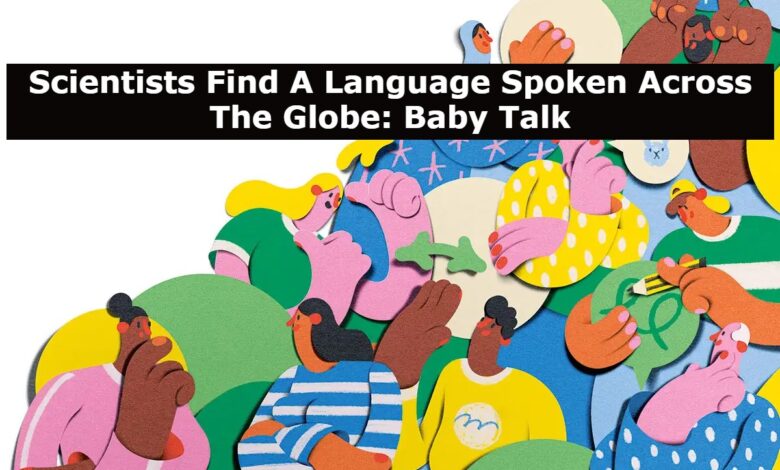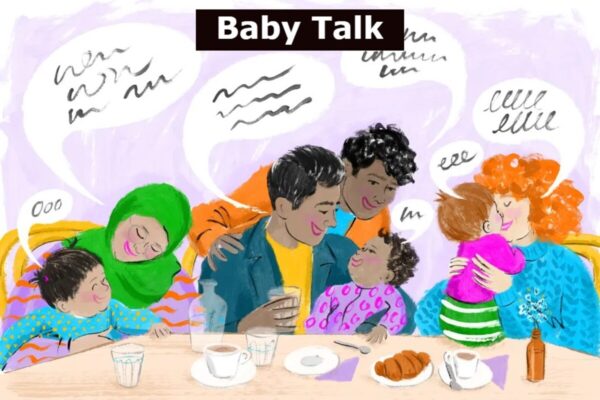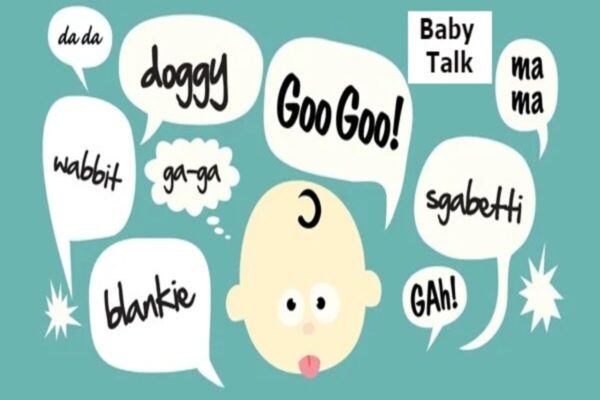Scientists Find A Language Spoken Across The Globe: Baby Talk

Scientists Find A Language Spoken Across The Globe: Baby Talk
A machine learning and citizen science survey have discovered that people sing and speak to young infants in a similar way across a variety of different languages, places, and societies. Know that you are not alone in your craziness the next time you find yourself babbling sing-songy gibberish to an amused baby.
According to the research, this has consequences for how language evolved, even pointing out some similarities to animal communication methods.
What is Baby Talk?

Baby talk, parentese, or, in the opinion of development scientists, infant-directed speech are all terms for the high-pitched, sing-song tone we adopt while engaging with young children. However simple the musical chitchat may appear, the talks are quite important.
Babies that were exposed to two languages showed greater interest in infant-directed speech or adult speech that sounds like a baby than in adult-directed speech, according to a study conducted by the University of California.
The development of speech and language depends heavily on baby babble. According to studies, newborns that are exposed to it every day for the first year of life have more developed vocabularies than other children. The particular tone of parentese, as evidenced by a recent study, captures the attention of children and makes them eager for it.
Researchers have identified crucial characteristics of the delicate exchanges between babies and caregivers around the world. When parents use these features, their children will learn more words and develop social skills.
The baby-directed speech wasn’t always seen favourably. Before the middle of the 20th century, researchers did not pay much attention. Many developmental psychologists and linguists thought that if left to our own devices, we would instinctively learn how to talk and form entire sentences from the late 1950s until the early 1990s, when linguist Noam Chomsky suggested that humans had an underlying aptitude for language.
Some doctors even gave parents the advice to refrain from using baby language because they felt it was foolish or patronizing. But over the past few decades, a number of studies have found that infants process, learn, and remember words presented to them in cooing tones better than conversations spoken in the adult language during the first year of life when they are regularly exposed to euphonious babble in addition to normal speech.
An International Study Confirms That “Parentese” Is a Lingua Franca

Adults speak and sing to babies in comparable ways all throughout the world, according to a thorough cross-cultural study.
According to a breakthrough new study, baby talk—the apparently calming but obviously meaningless gibberish we coo at babies—appears to be practically universal worldwide. Know that you are not alone in your craziness the next time you find yourself babbling sing-songy gibberish to an amused baby.
Researchers recently discovered that this sing-songy baby speaks, more properly called “parentese,” seems to be practically ubiquitous to humans around the world, regardless of whether it is helpful to be aware of it.
In one of the largest studies of its kind, over 40 scientists worked to collect and analyze 1615 voice recordings from 410 parents across six continents, in 18 languages, from various communities that ranged from Tanzanian hunter-gatherers to Beijing’s urban residents. These recordings came from a variety of communities that were both remote and connected to the internet.
The study, which was the most comprehensive of its kind, was published in the journal Nature Human Behaviour and examined more than 1,600 recordings of more than 400 individuals from 21 different societies throughout the world. The study, which included six continents and 18 different languages, discovered that while communicating with infants, people’s speech patterns shift in a manner that is essentially universal.
“Parentese,” as baby talk is more technically termed, can be heard everywhere, from densely crowded urban areas like Beijing to rural hunter-gatherer groups in Tanzania.
According to the research, baby talk and baby song serve a purpose that is not influenced by societal or cultural norms. They provide a starting point for future infant research and, to a certain extent, address the dearth of diversity in psychology. It takes research from many different societies to draw generalizations about human behaviour across cultures. There’s a large one now.
Scientists have long argued that human noises to their young serve a variety of critical evolutionary and developmental purposes. Human babies raised alone are “very lousy at their job of staying alive,” according to Samuel Mehr, a psychologist and the head of The Music Lab at Haskins Laboratories who came up with the new study’s concept. When we stare at a baby, we make weird vocalizations that help us live as well as teach language and communication.
Parentese, for instance, can aid in some infants’ word retention and enable them to piece together mouth forms and sounds to make sense of the pandemonium around them. Lullabies can also calm a wailing baby, and a louder voice can better keep their attention. Dr. Mehr stated that creating these tones and patterns by forcing air through your vocal tract is similar to giving the baby an analgesic.
But in presenting these claims, scientists, primarily from Western, developed nations, have largely presupposed that parents from all cultures alter their voices while speaking to young children. Casey Lew-Williams, a psychologist and the director of the Baby Lab at Princeton University who was not involved in the current study, said, “that was a risky assumption.”
Baby talk and song, according to Dr. Lew-Williams, “seem to give an on-ramp for language development,” but in certain cultures, “adults don’t talk to toddlers as often—and where they talk to them a lot.” Although desirable, theoretical uniformity could “wipe over the richness and texture of civilizations,” he claimed.

Greg Bryant, a cognitive scientist at the University of California, Los Angeles, who was not involved in the new research, said, “I’m probably the author with the most articles on this topic up to now, and this is simply blowing my stuff away.” You can hear these sounds wherever people are chatting to newborns in the world.
Animals use sound to communicate feelings and transmit information, such as impending danger and sexual interest, throughout the animal kingdom. The ability to discriminate between happy and sad noises emitted by animals, such as chickadees, alligators, pigs, and pandas, shows how similar species are. Therefore, it may not come as a surprise that human noises also have an identifiable emotional undertone.
According to Dr. Samuel Mehr, principal author of the study, “people use a higher voice while speaking to newborns than they do when speaking to adults across all sites.”
However, certain societies had significantly different pitch variances than others. Some of the biggest changes were in New Zealand English, whereas Hadza in Tanzania had less impact.
Globally, parentese is more musical, sings with a purer timbre, and changes speed in addition to using a higher, more varied pitch. A machine-learning program discovered that baby talk differed from adult talk in 11 different ways overall. The results indicated that there was variation among cultures, but this could still indicate a potential role for baby talk and baby song in infant development and parent-child connection.
The researchers contend that the results demonstrate that, despite cultural differences in language, music, and infant care methods, people adjust their speech and singing in “similar and mutually understandable” ways when speaking to or singing to a distressed baby.
According to co-first author Courtney Hilton and The Harvard Gazette, “Our work provides the greatest test yet of whether there are acoustic regularities in infant-directed vocalizations across countries.”
It is also the first to effectively address this issue in both speech and song at the same time. A highly enticing hint for a connection between infant-care methods and unique facets of our human psyche linked to music and sociality is provided by the consistency in vocal traits.
Previous studies have shown that regardless of the language they are in, lullabies or baby talk may be able to calm babies.
Researchers enlisted 51,065 participants for the new study, who came from 187 different nations and spoke 199 different languages. They wanted to know if the public could also tell the difference between baby talk and adult language.
Regardless of their home language or culture, participants were often able to determine whether a speech or song was intended for an adult or a baby.
Hilton summarized the key conclusions of the study on Twitter, saying that while there is variety and cultural influence in [baby talk], there do seem to be certain universal prejudices perhaps founded in our biology.
We hypothesize that this is a result of vocal emotion-signalling systems that are common to other animals and is inextricably linked to the extraordinarily prolonged and social circumstances of human child development, according to Hilton.
The researchers contend that in animals, certain sounds have converged for alarm calls or indicators of aggression, while other sounds have converged for close-contact calls that indicate friendliness or approachability.

The fundamental ways in which adults experience and use music—as an emotionally and socially potent signal that serves a variety of purposes in our lives—are in stark contrast to the ways in which we use these vocalizations to socially and emotionally communicate with infants and regulate their emotions.
According to research, uninformed listeners tend to stereotype songs for young children and discourse for adults.
According to the researchers, this is consistent with theories that claim song has a special relationship to infant care in human psychology. According to their hypothesis, listeners used “adult” and “baby” as the standard reference levels for speech and music, respectively, when evaluating acoustic evidence.
Edited by Prakriti Arora




